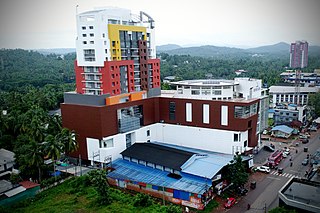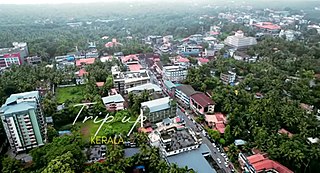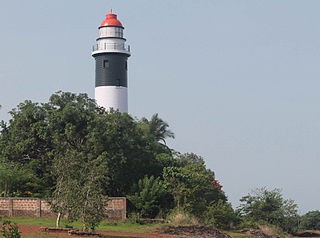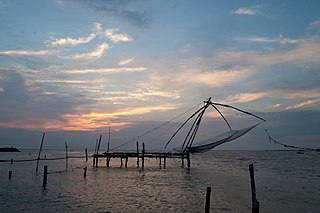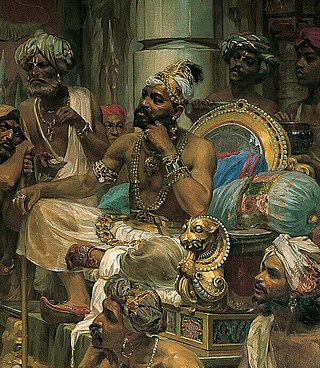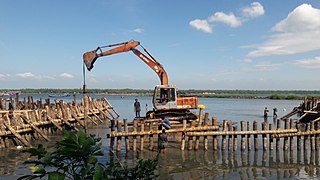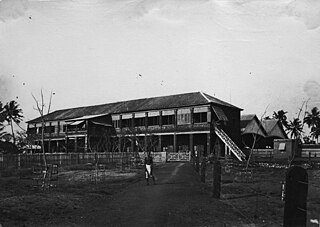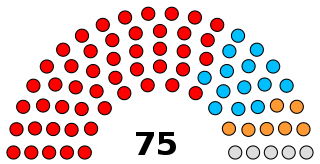Ponnani | |
|---|---|
 Chamravattom Regulator-cum-Bridge connects Ponnani with Tirur. Bharathappuzha river (Ponnani River) and Tirur River join with each other and empties together into Arabian Sea at Purathur (Southernmost tip of Tirur Taluk), which lies opposite of Ponnani Port. | |
| Nickname(s): | |
| Coordinates: 10°46′N75°54′E / 10.77°N 75.9°E | |
| Country | |
| State | Kerala |
| District | Malappuram |
| Area | |
| • Total | 24.82 km2 (9.58 sq mi) |
| Population (2011) [4] | |
| • Total | 90,491 |
| • Density | 3,600/km2 (9,400/sq mi) |
| Time zone | UTC+5:30 (IST) |
| Postal Index Number | 679 577 |
| Telephone code | 0494 |
| Vehicle registration | KL-54 |
| Website | www |
Ponnani (Malayalam: [ponːaːni] ) is a municipality in Ponnani Taluk, Malappuram District, in the state of Kerala, India. It serves as the administrative center of the Taluk and Block Panchayat of the same name. It is situated at the estuary of Bharatappuzha (River Ponnani), on its southern bank, and is bounded by the Arabian Sea on the west and a series of brackish lagoons in the south.
Contents
- Names
- Etymology
- History
- Pre-Portuguese Era: the Centre of Muslim trade
- Portuguese era
- Dutch Factory
- Under the Sultans of Mysore
- Ponnani Canal
- Response to British Colonial Rule
- The Makhdums of Ponnani
- Ponnani Cuisine
- Demographics
- Places of Interest
- Civic administration
- Ponnani Municipality Election 2020[51]
- Law and Order
- Wards of Ponnani
- Ponnani Block
- Geography
- Transportation
- References
- Further reading
- External links
It is the seventh-most populated municipality in the state, the second-most populated municipality in the district, and the most densely populated municipality in Malappuram district, having about 3,646 residents per square kilometre as of the year 2011. [5] As of the 2011 Census, the municipality forms a part of Malappuram metropolitan area. National Highway 66, from to Panvel to Kanyakumari, passes through Ponnani Municipality. [6] The Palakkad-Ponnani State Highway which connects National Highway 66 with National Highway 544 is another important road. The River Tirur joins River Ponnani at its mouth at Patinjarekkara Beach from the north bank, opposite to Ponnani. The Colonial-era Cannoly Canal ("the Ponnani Canal") bisects Ponnani town. [7] Ponnani is located 68 km south to Kozhikode city, 48 km southwest to Malappuram city, 91 km northwest to Palakkad city, and 50 km northwest to Thrissur city. Ponnani is located right in the middle of the Kerala coast.
In the Middle Ages, under the ambitious Hindu chiefs of Kozhikode (the Samutiris/Zamorins), Ponnani developed as one of the most important centers of Muslim trade - both overseas and domestic - on the Arabian Sea. The port also served as the military headquarters of the Kozhikode rulers. With the arrival of the Portuguese explorers in the late - 15th century, the city witnessed several battles between the Admirals of Kozhikode and the Portuguese for the monopoly in the Spice Trade. Whenever a formal war was broke out between the Portuguese and the Kozhikode rulers, the Portuguese attacked and plundered, as the opportunity offered, the port of Ponnani. The relentless battles lead to the eventual decline of the settlement, with the exodus of Middle Eastern merchants, and the rulers who protected it. Presently, Ponnani is one of the major fishing centers in Kerala. [8] [9] [10] [11]
The original headquarters of the Perumbadappu Swaroopam, who later became the Kingdom of Cochin, was at Chithrakoodam in Vanneri, Perumpadappu, which is located 10 km south to Puthuponnani, in Ponnani taluk. When Perumpadappu came under the kingdom of the Zamorin of Calicut, the rulers of Perumpadappu fled to Kodungallur, and later they moved to Kochi, where they established the Kingdom of Cochin.
The city of Ponnani also provided ideological support for the battles against the Estado da Índia. It was the home of the revered Makhdum family. Prominent members of this Yemeni family of Islamic theologians included Zain-ud-Din Makhdum I (1467 - 1521) and his grandson Zain-ud-Din Makhdum II (1530 - 1581). Makhdum II is known for his formidable historical chronicle Tuhfat al-Mujahidin ("Glory to the Victory of Mujahidun", c. 1583), first printed and published in Lisbon. A copy of this edition has been preserved in the library of Al-Azhar University, Cairo. [8] [9] [10] [11]
The Ponnani Jum'ah Masjid, also known as Valiya Jum'ah Palli/Makhdum Mosque, was built in the 16th century AD. Ponnani, once known as the "Little Mecca of Malabar" and the "Jami'at al-Azhar of Malabar", was a prominent center of Islamic learning. It is known that students from as far as Sumatra, Java and Sri Lanka traveled to Ponnani for their spiritual education. [8] [6] [7] The town was described in many sources as "the Land of 23½ Mosques". It currently has around 50 mosques, spread around the town. [12]
During the months of February and March, large number of migratory birds flock at Ponnani (both Ponnani and Patinjarekkara Beaches). Arabi Malayalam script, a script used to write Malayalam, was originated at Ponnani. The script was also known as "the Ponnani Script". [6] Bharathappuzha, also known as the Ponnani River, has contributed much to the Malayalam literature.




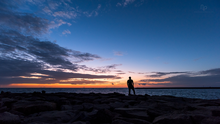








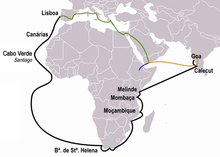


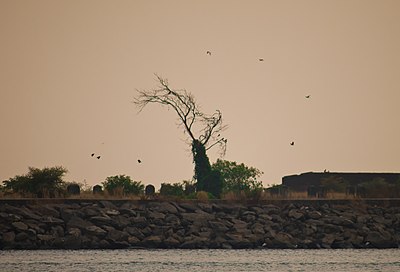
![Ponnani harbour in the mid-1930s mlppurrN jillyi[?] ponnaaniyile haa[?]b[?] (1930-37).jpg](http://upload.wikimedia.org/wikipedia/commons/thumb/4/4e/%E0%B4%AE%E0%B4%B2%E0%B4%AA%E0%B5%8D%E0%B4%AA%E0%B5%81%E0%B4%B1%E0%B4%82_%E0%B4%9C%E0%B4%BF%E0%B4%B2%E0%B5%8D%E0%B4%B2%E0%B4%AF%E0%B4%BF%E0%B5%BD_%E0%B4%AA%E0%B5%8A%E0%B4%A8%E0%B5%8D%E0%B4%A8%E0%B4%BE%E0%B4%A8%E0%B4%BF%E0%B4%AF%E0%B4%BF%E0%B4%B2%E0%B5%86_%E0%B4%B9%E0%B4%BE%E0%B5%BC%E0%B4%AC%E0%B5%BC_%281930-37%29.jpg/300px-%E0%B4%AE%E0%B4%B2%E0%B4%AA%E0%B5%8D%E0%B4%AA%E0%B5%81%E0%B4%B1%E0%B4%82_%E0%B4%9C%E0%B4%BF%E0%B4%B2%E0%B5%8D%E0%B4%B2%E0%B4%AF%E0%B4%BF%E0%B5%BD_%E0%B4%AA%E0%B5%8A%E0%B4%A8%E0%B5%8D%E0%B4%A8%E0%B4%BE%E0%B4%A8%E0%B4%BF%E0%B4%AF%E0%B4%BF%E0%B4%B2%E0%B5%86_%E0%B4%B9%E0%B4%BE%E0%B5%BC%E0%B4%AC%E0%B5%BC_%281930-37%29.jpg)


![The Ponnani Canal at Ponnani (in the 1930s) ponnaaniyile oru knaa[?] (1930-1937).jpg](http://upload.wikimedia.org/wikipedia/commons/thumb/3/3f/%E0%B4%AA%E0%B5%8A%E0%B4%A8%E0%B5%8D%E0%B4%A8%E0%B4%BE%E0%B4%A8%E0%B4%BF%E0%B4%AF%E0%B4%BF%E0%B4%B2%E0%B5%86_%E0%B4%92%E0%B4%B0%E0%B5%81_%E0%B4%95%E0%B4%A8%E0%B4%BE%E0%B5%BD_%281930-1937%29.jpg/390px-%E0%B4%AA%E0%B5%8A%E0%B4%A8%E0%B5%8D%E0%B4%A8%E0%B4%BE%E0%B4%A8%E0%B4%BF%E0%B4%AF%E0%B4%BF%E0%B4%B2%E0%B5%86_%E0%B4%92%E0%B4%B0%E0%B5%81_%E0%B4%95%E0%B4%A8%E0%B4%BE%E0%B5%BD_%281930-1937%29.jpg)










